Gamma dosimetry is the measurement, calculation, and assessment of the absorbed doses and assigning those doses to individuals. The science and practice attempt to quantitatively relate specific measures made in a radiation field to chemical and/or biological changes that the radiation would produce in a target.
Since there are two types of radiation exposure, external and internal exposure, dosimetry may also be categorized as:
- External Dosimetry. External exposure is radiation from outside our body that interacts with us. In this case, we analyze exposure predominantly from gamma rays and beta particles since alpha particles generally constitute no external exposure hazard because the particles generally do not pass through the skin. Since photons and beta interact through electromagnetic forces and neutrons interact through nuclear forces, their detection methods and dosimetry are substantially different. For example, the radiation source can be a piece of equipment that produces the radiation, like a container with radioactive materials or an x-ray machine. External dosimetry is based on measurements with a dosimeter or inferred from measurements made by other radiological protection instruments.
- Internal Dosimetry. If the radiation source is inside our body, we say it is internal exposure. The intake of radioactive material can occur through various pathways, such as ingesting radioactive contamination in food or liquids. Protection from internal exposure is more complicated. Most radionuclides will give you much more radiation dose if they can somehow enter your body than they would if they remained outside. Internal dosimetry assessment relies on various monitoring, bio-assay, or radiation imaging techniques.
Studies have shown that alpha and neutron radiation cause greater biological damage for a given energy deposition per kg of tissue than gamma radiation. Biological effects of any radiation increase with the linear energy transfer (LET) were discovered. In short, the biological damage from high-LET radiation (alpha particles, protons, or neutrons) is much greater than that from low-LET radiation (gamma rays). This is because the living tissue can more easily repair damage from radiation spread over a large area than that concentrated in a small area. Because more biological damage is caused for the same physical dose (i.e., the same energy deposited per unit mass of tissue), one gray of alpha or neutron radiation is more harmful than one gray of gamma radiation. The fact that radiations of different types (and energies) give different biological effects for the same absorbed dose is described in terms of factors known as the relative biological effectiveness (RBE) and the radiation weighting factor (wR).
Radiation Weighting Factors – ICRP
For photon and electron radiation, the radiation weighting factor has the value of 1, independently of the energy of the radiation, and for alpha radiation, the value is 20. For neutron radiation, the value is energy-dependent and amounts to 5 to 20.
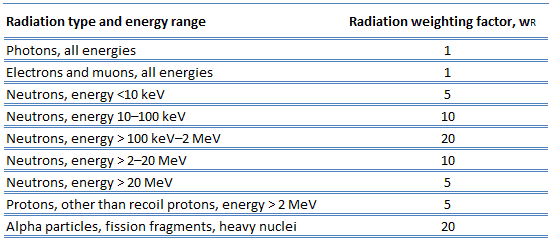
In 2007 ICRP published a new set of radiation weighting factors(ICRP Publ. 103: The 2007 Recommendations of the International Commission on Radiological Protection). These factors are given below.
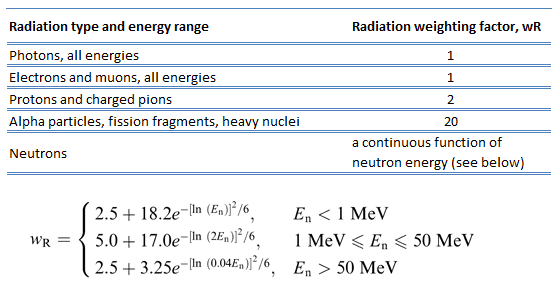
As shown in the table, a wR of 1 is for all low-LET radiations, i.e., X-rays and gamma rays of all energies as well as electrons and muons. A smooth curve, considered an approximation, was fitted to the wR values as a function of incident neutron energy. Note that En is the neutron energy in MeV.
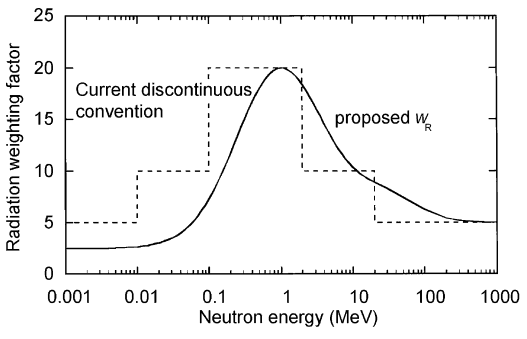
Thus, for example, an absorbed dose of 1 Gy by alpha particles will lead to an equivalent dose of 20 Sv, and an equivalent dose of radiation is estimated to have the same biological effect as an equal amount of absorbed dose of gamma rays, which is given a weighting factor of 1.
Detectors of Gamma Radiation
Detectors may also be categorized according to sensitive materials and methods that can be utilized to make a measurement:
Detection of Gamma Radiation using Ionization Chamber
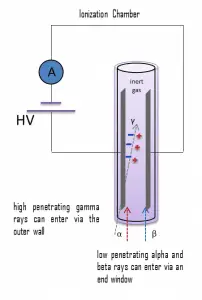
Gamma rays have very little trouble penetrating the metal walls of the chamber. Therefore, ionization chambers may be used to detect gamma radiation and X-rays, collectively known as photons, and for this, the windowless tube is used. Ionization chambers have a uniform response to radiation over a wide range of energies and are the preferred means of measuring high levels of gamma radiation. Some problems are caused by alpha particles being more ionizing than beta particles, and gamma rays, so more current is produced in the ionization chamber region by alpha than beta and gamma. Gamma rays deposit a significantly lower amount of energy into the detector than other particles.
Using a high-pressure gas can further increase the chamber’s efficiency. Typically a pressure of 8-10 atmospheres can be used, and various noble gases are employed. For example, high-pressure xenon (HPXe) ionization chambers are ideal for use in uncontrolled environments, as a detector’s response is uniform over large temperature ranges (20–170°C). The higher pressure results in a greater gas density and thereby a greater chance of collision with the fill gas and ion-pair creation by incident gamma radiation. Because of the increased wall thickness required to withstand this high pressure, only gamma radiation can be detected. These detectors are used in survey meters and for environmental monitoring.
Detection of Gamma Radiation using Geiger Counter

Geiger counter can detect ionizing radiation such as alpha and beta particles, neutrons, and gamma rays using the ionization effect produced in a Geiger–Müller tube, which gives its name to the instrument. The voltage of the detector is adjusted so that the conditions correspond to the Geiger-Mueller region.
The high amplification factor of the Geiger counter is the major advantage over the ionization chamber. The Geiger counter is a much more sensitive device than other chambers. This is often used to detect low-level gamma rays and beta particles.
Detection of Gamma Radiation using Scintillation Counter
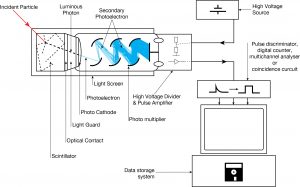
Scintillation counters are used to measure radiation in various applications, including hand-held radiation survey meters, personnel and environmental monitoring for radioactive contamination, medical imaging, radiometric assay, nuclear security, and nuclear plant safety. They are widely used because they can be made inexpensively yet with good efficiency and can measure both the intensity and the energy of incident radiation.
Scintillation counters can be used to detect alpha, beta, and gamma radiation, and they can also be used for the detection of neutrons. For these purposes, different scintillators are used.
- Gamma Rays. High-Z materials are best suited as scintillators for the detection of gamma rays. NaI(Tl) (thallium-doped sodium iodide) is the most widely used scintillation material. The iodine provides most of the stopping power in sodium iodide (since it has a high Z = 53). These crystalline scintillators are characterized by high density, high atomic number, and pulse decay times of approximately 1 microsecond (~ 10-6 sec). Scintillation in inorganic crystals is typically slower than in organic ones. They exhibit high efficiency for the detection of gamma rays and are capable of handling high count rates. Inorganic crystals can be cut to small sizes and arranged in an array configuration to provide position sensitivity. This feature is widely used in medical imaging to detect X-rays or gamma rays. Inorganic scintillators are better at detecting gamma rays and X-rays. This is due to their high density and atomic number, which gives a high electron density.
Detection of Gamma Radiation using Semiconductors – HPGe Detectors
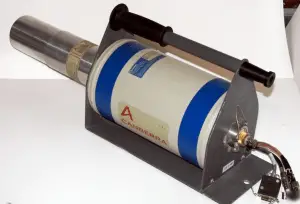
High-purity germanium detectors (HPGe detectors) are the best solution for precise gamma and x-ray spectroscopy.
As was written, gamma spectroscopy is used to study and analyze gamma-ray spectra for scientific and technical use. Gamma-ray spectrometers are the instruments that observe and collect such data. A gamma-ray spectrometer (GRS) is a sophisticated device for measuring the energy distribution of gamma radiation. For the measurement of gamma rays above several hundred keV, there are two detector categories of major importance, inorganic scintillators such as NaI(Tl) and semiconductor detectors. If a perfect energy resolution is required, we have to use a germanium-based detector, such as the HPGe detector. Germanium-based semiconductor detectors are most commonly used where a very good energy resolution is required, especially for gamma spectroscopy as well as x-ray spectroscopy. In gamma spectroscopy, germanium is preferred due to its atomic number being much higher than silicon, increasing the probability of gamma-ray interaction. Moreover, germanium has lower average energy necessary to create an electron-hole pair, which is 3.6 eV for silicon and 2.9 eV for germanium. This also provides the latter with a better resolution in energy. The FWHM (full width at half maximum) for germanium detectors is an energy function. For a 1.3 MeV photon, the FWHM is 2.1 keV, which is very low.
EPD – Electronic Personal Dosimeter

An electronic personal dosimeter is a modern dosimeter that can give a continuous readout of cumulative dose and current dose rate and warn the person wearing it when a specified dose rate or a cumulative dose is exceeded. EPDs are especially useful in high-dose areas where the residence time of the wearer is limited due to dose constraints.
Characteristics of EPDs
The electronic personal dosimeter, EPD, can display a direct reading of the detected dose or dose rate in real-time. Electronic dosimeters may be used as supplemental dosimeters as well as primary dosimeters. The passive and electronic personal dosimeters are often used together to complement each other. Dosimeters must be worn on a position of the body representative of its exposure to estimate effective doses, typically between the waist and the neck, on the front of the torso, facing the radioactive source. Dosimeters are usually worn outside clothing, around the chest or torso to represent dose to the “whole body.” Dosimeters may also be worn on the extremities or near the eye to measure equivalent doses to these tissues.
The dosimeter can be reset, usually after taking a reading for record purposes, and thereby re-used multiple times. The EPDs have a top-mounted display to make them easily read when clipped to your breast pocket. The digital display gives both dose and dose rate information, usually in mSv and mSv/h. The EPD has a dose rate alarm and a dose alarm. These alarms are programmable, and different alarms can be set for different activities.
For example:
- dose rate alarm at 100 μSv/h,
- dose alarm: 100 μSv.
If an alarm set point is reached, the relevant display flashes along with a red light, and quite a piercing noise is generated. You can clear the dose rate alarm by retreating to a lower radiation field, but you cannot clear the dose alarm until you get to an EPD reader. EPDs can also give a bleep for every 1 or 10 μSv they register, giving you an audible indication of the radiation fields. Some EPDs have wireless communication capabilities. EPDs can measure a wide radiation dose range from routine (μSv) levels to emergency levels (hundreds mSv or units of Sieverts) with high precision. They may display the exposure rate and accumulated exposure values. Of the dosimeter technologies, electronic personal dosimeters are generally the most expensive, largest in size, and the most versatile.